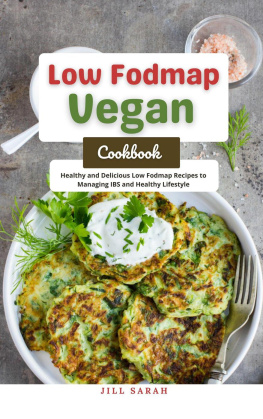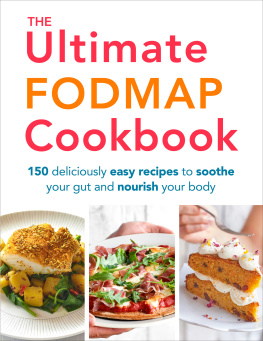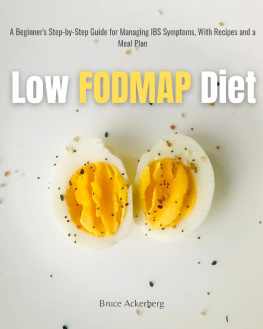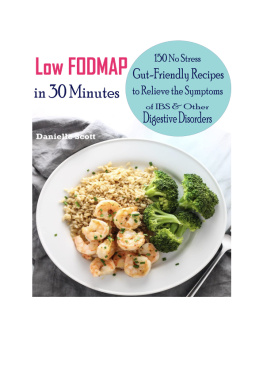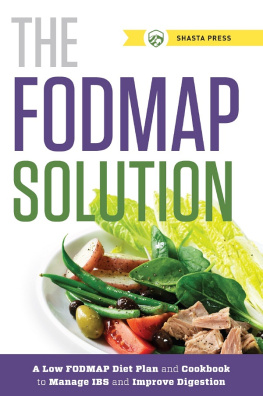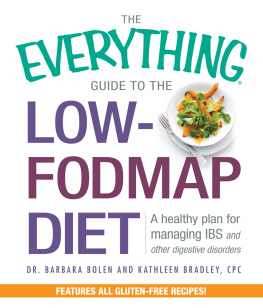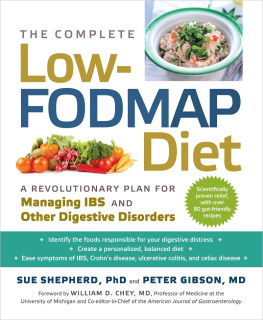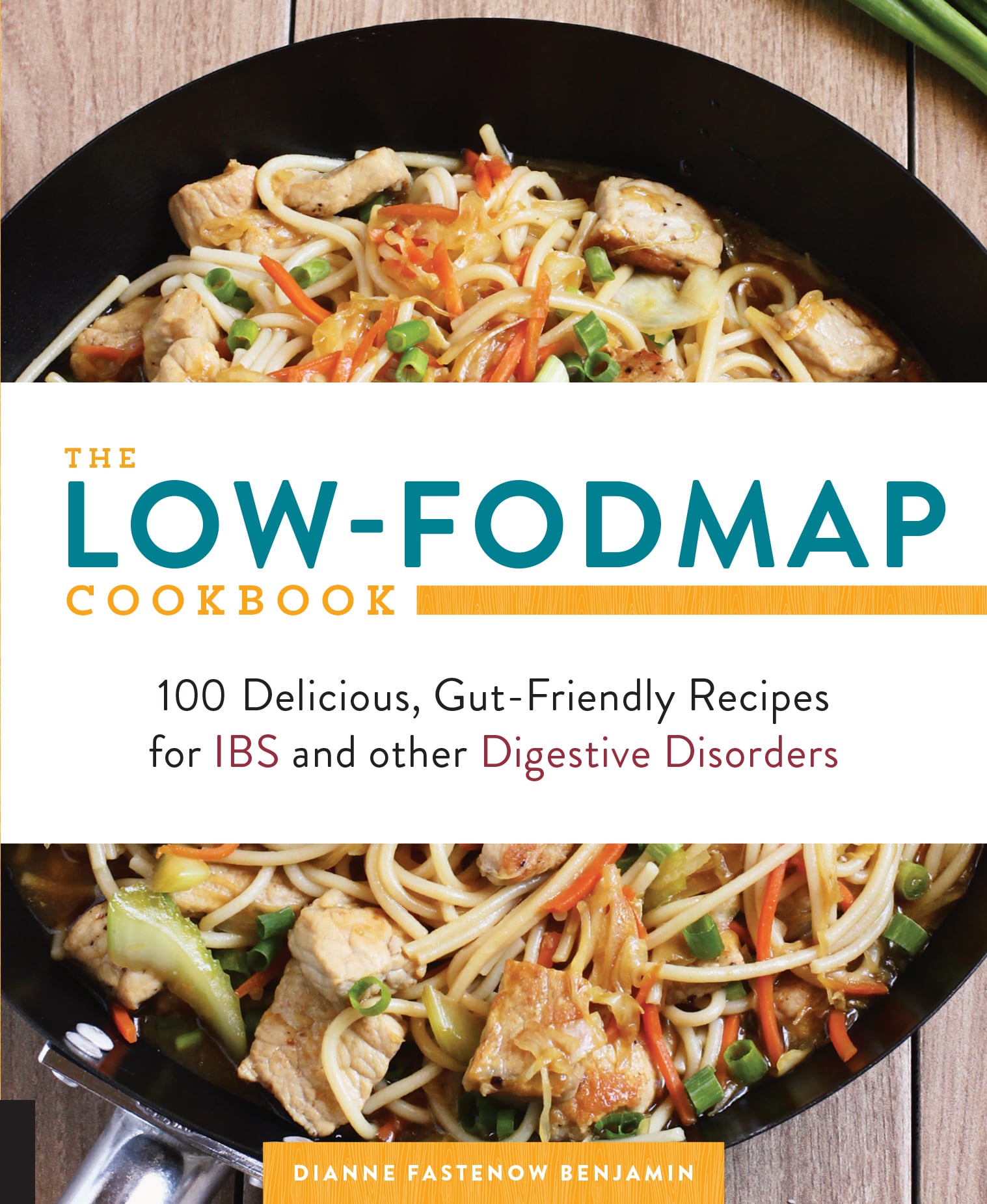THE
LOW-FODMAP
COOKBOOK
100 Delicious, Gut-Friendly Recipes for IBS and other Digestive Disorders
DIANNE FASTENOW BENJAMIN

CONTENTS
Guide
INTRODUCTION
My passion for food began when I was about eight or nine years old. I had a Better Homes and Gardens kids cookbook that I loved: My mom taught me how to follow the recipes, and my friends and I baked and bakedand baked some more. Ive got vivid memories of making treats like snickerdoodles, yellow cake with chocolate frosting, and caramel corn. (That caramel corn was so good that my dad still talks about it to this day!)
We dont have any chefs or restaurateurs in our familyunless you count my great-great-grandfather, who was a bakerbut food has always been a big part of our lives. After my husband and I got married, we noticed a major difference in our respective families. When we get together with his family, the question on everyones lips is, What are we doing today? But when we get together with my family, everyone asks, What are we eating today? Food is truly the main event: Vacations, holidays, and birthdays are always centered around whereand whatwere going to eat. So its no surprise that Ive been collecting and creating recipes almost obsessively since I was a teenager or that I love to share recipes that Ive tried and created on my blog, Delicious as it Looks (www.deliciousasitlooks.com). I started Delicious as it Looks in 2010, after I discovered my talent for photographing food. I was still eating like an average person back then; but while I tried to eat as healthfully and naturally as possible, my digestive system was a mess.
I was diagnosed with irritable bowel syndrome (IBS) almost twenty years ago. Symptoms would come and go: Sometimes Id feel okay, but the rest of the time I felt like there was something seriously wrong with me. Finally, after all my tests came back normal, I got the IBS diagnosis. I continued to suffer until I finally took matters into my own hands and began researching how diet affects IBS. That was nothing new for me: Ive been interested in health and nutrition since I lost fifty pounds as a teenager by counting calories, exercising, and using diet tips gleaned from womens magazines, so taking the initiative and researching diets and digestive issues felt like a natural extension of that curiosity.
At last I landed on the low-FODMAP diet, which completely changed my life. Suddenly, everything made sense. The foods I was eating were actually causing my symptoms! It was a revelation at the time, but looking back, it seems so obvious. So why did I have to figure this out all by myself? The answer is simple: I was diagnosed before anyone had even heard of FODMAPs. And that means I missed out. (These days, I hope IBS sufferers will learn about FODMAPs from their doctors when theyre diagnosed.)
And, of course, adopting a low-FODMAP diet posed a challenge for my blog. Now what? I thought. I cant eat anything! But it wasnt long before I made the decision to stay positive and to focus on all of the foods I can eat. After that, I started developing recipes that use low-FODMAP ingredients and sharing them on my blog. If you look through my blogs archives, youll see how I transitioned from a normal diet to a low-FODMAP one (and how I dabbled in a grain-free diet for a while en route). Its been such an interesting and enjoyable experience, and the best part is that my experienceand my recipeshave helped so many people.
Its my hope that this book will help you, too. It will show you how to make 100 low-FODMAP recipes, everything from hearty stews to healthy pasta dishes to decadent chocolate chip cookies. Im confident it will prove that eating low-FODMAP is anything but boring! Also, as youll see, lots of these recipes can easily be made vegan with just a couple of simple substitutions and many of them are gluten-free, too.
Lets get started!
Dianne Fastenow Benjamin
FODMAPS AND THE LOW-FODMAP DIET
Irritable bowel syndrome (IBS) affects about 20 percent of adults in the United States, and recent research shows that enjoying a low-FODMAP diet can help drastically reduce your IBS symptoms. But what are FODMAPs, and what do they mean for your digestive system? Its a fairly complicated subject, but I will break it down for you so that will have an understanding of the following:
What FODMAPs are
What common foods contain FODMAPs
Why FODMAPs cause digestive issues in some people
How the diet works, including the elimination and rechallenge phases
The difference between a food intolerance and a food allergy
How to improve your digestion
What foods to enjoy on the low-FODMAP diet
FODMAP stands for Fermentable, Oligosaccharides, Disaccharides, Monosaccharides, And Polyols. These are carbohydrates (or sugars) that are poorly absorbed in the small intestine. They end up traveling to the large intestine, where they become the perfect food for the bacteria that live in the large intestine. The bacteria eat away at these sugars and cause fermentation, which results in nasty symptoms like gas, pain, cramping, diarrhea, constipation, and nauseatypical symptoms for people who suffer from IBS. Being small molecules, they also attract water into the small intestine, causing symptoms. The term FODMAPs has been coined relatively recently, and its getting a lot of press in the diet and nutrition world these days since some people who thought they were sensitive to dietary gluten have realized that theyre actually suffering from a sensitivity to the fructans, or sugars, in wheat.
Research from Monash University in Melbourne, Australia, shows that avoiding FODMAPs can greatly improve symptoms in up to 76 percent of IBS patients.
Before we launch into the details of the low-FODMAP diet, lets start with a brief refresher course in nutrition. The food we eat consists of three components: carbohydrates, proteins, and fats. Some foods consist mostly of protein (like the extra-lean ground turkey in tacos) and some foods consist of fat (like the olive oil you drizzle on salads). Other foods are completely carbohydrate-based, like the sugar you sprinkle on your morning oatmeal. And in terms of a low-FODMAP diet, the component were most concerned about is carbohydrates.
Carbohydrates, which consist of sugars, starches, and fiber, are an important component of our diets since they provide our bodies with energy. Heres how: Our digestive systems break down the carbs we eat until they can be absorbed through the intestinal wall into the bloodstream, where theyre converted into energy. And theyre in a lot of the foods we eat, including fruits, vegetables, breads, and pasta. But certain carbsthe FODMAPscan cause issues in people with IBS and other digestive disorders.


